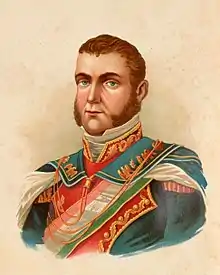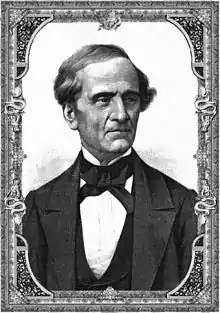Monarchism in Mexico
Monarchism in Mexico was a recurring political factor in the first decades of the nation's existence. The nation became independent under a coalition hoping to establish a government led by a member of the Spanish royal family or a prince from another European royal house. The Mexican general Agustin de Iturbide was elected emperor by the Mexican congress in 1822 with the hopes of inaugurating a constitutional monarchy, but struggles between congress and the emperor led to the empire's collapse the following year.

Largely discredited in the wake of the First Mexican Empire's fall, monarchism remained dormant until the 1840s when select conservative thinkers began to publicly explore the idea as a means of giving the nation a stability which it had never found while trying a republican form of government. Iturbide was dismissed as an upstart, and monarchy was hoped to be tried again with a member of European nobility.
These ideas attracted interest in European courts, culminating in a French invasion of Mexico in 1861 with the aim of establishing a Mexican monarchy as a French client state, this time with Archduke Ferdinand Maximilian as Emperor. The Empire gained some Mexican support, and attempted liberal reforms, but the establishment of the Empire through French troops damaged its legitimacy, triggered a war with the overthrown Mexican republican leadership, and invited the opposition of the United States, leading to the Empire's collapse in 1867.
The Spanish Legacy
For over 300 years, the colony of New Spain was ruled by viceroys representing the King of Spain. Only three of the viceroys were ever born in Mexico, the rest having been born in Spain, and usually going back after a few years of ruling.
During this time, two royal houses ruled Mexico. The House of Habsburg ruled Mexico from the conquest up until the War of Spanish Succession in 1714 when control of Spain and her colonies passed over to the House of Bourbon which began a program of modernization known as the Bourbon Reforms.
The first serious proposal for an independent Mexican monarchy came about after Spain's support for the successful American War of Independence, Count Aranda, one of the king's ministers proposed to King Charles IV the establishment of a Spanish Commonwealth with independent kingdoms in New Spain, Peru, and New Granada as a compromise between Spain's colonial interests and the strengthening trend of decolonization.[1]
Monarchism and Mexican Independence

Mexico gained its independence in 1821, under the leadership of Agustin de Iturbide who sought to revive the commonwealth idea through the Plan of Iguala, which stipulated for Mexico to be an independent monarchy, nonetheless with a monarch from the royal Spanish family. The plan was ratified by the Spanish viceroy Juan O'Donojú through the Treaty of Cordoba and commissioners were sent to Spain to offer the Mexican throne to a Spanish prince. The Spanish government however, rejected the matter out of fear that any concession in favor of Mexican independence would cause Spain to entirely lose its influence in Mexico, and under the false assumption that there was still a significant pro-Spanish party in Mexico.[2]
After news of the rejection arrived in Mexico there were mass demonstrations in favor of elevating Iturbide to the throne, and congress held an extraordinary session on the matter. Within congress there were both monarchists and republicans, but monarchism at this point was divided at this point into two factions: those in favor of crowning Iturbide, and those who had not yet given up hopes on inviting a Spanish prince to the throne.[3] On May 18, 1822, congress elected Agustin de Iturbide as Mexico's first Emperor.
It was around this time that José Joaquín Fernández de Lizardi wrote a monarchist pamphlet, endorsing the establishment of a constitutional monarchy under Iturbide, recognizing the debates going on at the time over the ideal form of government for Mexico, but also arguing that the form of government matter less than whether or not a government acts justly.[4] Lizardi also published a pro-Iturbide newspaper known as Pensador Mexicano.[5]
After his coronation, Iturbide alienated his supporters when in the struggles between congress and the crown, it became clearer that Iturbide wanted to totally dominate the legislature, betraying the ideal of a constitutional monarchy. The military turned against Iturbide when he shut congress down and being unable to defeat the insurrection, Iturbide reassembled congress, and offered his abdication in April, 1823 being exiled from the nation shortly after. When he attempted to return in 1824, Iturbide was captured and executed.
In 1828, Spain tried to reconquer Mexico, and the conservative paper El Sol pondered the Bourbonist cause, ultimately arguing that it was futile to join the Spaniards when popular opinion against Bourbon rule was overwhelming, and so it urged all its readers to unite patriotically against the Spanish intervention.[6]
Gutierrez Estrada's Essay
The Republican system prevailed through the following decades, and the nation suffered much turmoil, including multiple coups, financial insolvency, and the loss of Texas.
In 1840, during the conservative administration of President Anastasio Bustamante, José María Gutiérrez de Estrada published a pamphlet advocating a constitutional convention to examine what had gone wrong with the nation. He also argued that the convention ought to be given the power to suggest any form of government as a remedy for Mexico, and openly argued that in his own opinion a monarchy headed by a foreign prince was the best form of government for Mexico at the time.[7]
He strongly criticized the notion that there was one ideal form of government for all nations and all circumstances and pointed out the troubles that liberals even in France were experiencing trying to set up republic in recent times.[8] He also warned that the chaos Mexico was experiencing was inevitably leading to foreign intervention. He warned of a future American annexation of Mexico, and preferred to at least have the choice of selecting a foreign monarch who would have a vested interest in the success of Mexico.[9]
The Mexican government reacted to the pamphlet by characterizing it as treasonous and as an incitement to civil war. Multiple refutations were penned. The publisher was imprisoned, and Gutierrez Estrada was exiled to Europe.[10] Nonetheless, the Mexican-American War bore out some of Estrada's predictions, encouraging him in his continued campaign to establish a monarchy.[11]
El Tiempo

On December, 1845 at a time of rising tensions with the United States, Mariano Paredes led a coup against the government of Jose Joaquin Herrera. Paredes was known to have monarchist sentiments and in his address upon assuming power, praised the former Spanish administration of the nation, and implied that a monarchy would be beneficial for the nation.[12] While a constituent congress was elected, monarchists in Mexico now launched the first serious campaign to establish a monarchy in the nation since the days of the First Empire.[13] The Mexican minister to Spain was reported to have been given instructions to sound out the idea of a Bourbon restoration in Mexico at European courts.[14]
Lucas Alaman began publishing a newspaper in January, 1846 called El Tiempo, which simply started out as a conservative paper arguing that Mexico must be willing to explore what form of government was most suitable for the nation.
The paper blamed American influence for causing damage to Mexican political thought. The framers of the 1824 Constitution of Mexico copied the institutions of the United States, under the assumption that it was those institutions that were responsible for the wealth of the nation, but the paper argued that the United States had great wealth even in colonial times, and that many monarchies in Europe were prosperous as well. They ascribed the wealth of the United States to their trade with Britain, and the continuation of such commercial links after independence.[15] It was also argued that constitutions lack the power to create societies, but are rather the codifications of societial customs that have developed over time and that a constitution must fit the custom, character, and requirements of each nation.[16][17] The paper eventually moved away from simply advocating that Mexico find a more suitable form of government and openly endorsed constitutional monarchy, arguing that liberty, democracy, and national development can exist well under such a state, as demonstrated by the leading nations of the time. [18]
The liberal paper, La Reforma, began a back and forth dispute with El Tiempo, attempting to refute each of its points. The editors of La Reforma nonetheless welcomed discussion on the merits of monarchy, but warned El Tiempo's staff that a call for foreign intervention ought to be prosecuted as treason.[19]
On June 6, 1846, President Paredes addressed the newly elected congress. The legislature was divided politically, and in the face of an American invasion that had begun the previous April, Paredes did not pursue any monarchical project and openly endorsed republicanism. El Tiempo condemned him and shut down shortly afterward.[20]
El Universal
Mexican political thinkers were in a state of exasperation following the international humiliation and dismemberment of the nation in by the United States in the Mexican-American War. The disaster of the war helped contribute to a resurgence in monarchism, to the point that in a letter between liberal thinkers Jose Luis Mora and Mariano Otero, Mora opined that the monarchist party may have been triumphant in Mexico if the monarchy had not just been overthrown in France in the Revolution of 1848, thus influencing the political fashion in favor of republicanism.[21]
In the aftermath of the Mexican–American War, the cause by El Tiempo was taken up by the newspaper El Universal, once again under the influence of Lucas Alaman. It began publication in Mexico City on November, 1848. Much like El Tiempo, it took up the tactic of implying monarchy was the best form of government for Mexico rather than outright stating it. Its articles tended to criticize the federal organization of the Mexican Republic, as established in the 1824 Constitution.
Alaman's Last Attempt
In 1853, a coup overthrew president Mariano Arista, and Lucas Alaman invited Santa Anna to assume the presidency of the nation, intending for him to hold power only until a foreign monarch could be found. Alaman was made Secretary of Foreign Relations, and he revealed his monarchist project to the French minister Andre Levasseur.[22] The government established contact with Jose Maria Gutierrez Estrada and granted him official diplomatic credentials, instructing him to start looking for a royal candidate among the courts of Britain, France, Austria-Hungary, and Madrid.[23] Upon the suggestion of Estrada, another monarchist, Jose Maria Hidalgo was granted a diplomatic post in Spain in order to seek a Spanish candidate for the throne.[24]
Lucas Alaman died on June 2, 1853, and in 1855, another coup overthrew Santa Anna, and Estrada and Hidalgo lost official government recognition, and ending the official effort to seek a monarchy for Mexico.
The French Intervention

Estrada and Hidalgo continued their campaign for the establishment of a Mexican monarchy in spite of no longer having any government accreditation. Gutierrez met with Napoleon III in June 1857. Hidalgo regained an official diplomatic post with the Mexican government, but with no authority or instructions to pursue any monarchist project. The most important connection which Hidalgo made was with Eugénie de Montijo, a Spanish noblewoman who at this time was wife of Napoleon III. She became enthusiastic about the idea of a Mexican monarchy, and began to lobby for the matter with her husband.[25]
The Marquis de Radepont, while living in Mexico managing haciendas, became intrigued by the idea of a Mexican monarchy after hearing the idea supported by prominent Mexicans. He wrote an essay aimed at the French government explaining how this could come about with the support of France. He also argued that such a Mexican Empire could serve as a barrier to American expansion, comparing it to the European situation in which the Ottoman Empire was viewed as an important barrier to Russian expansion.[26]
President of the Mexican Supreme Court at the time Luis de la Rosa expressed his support for a monarchy to French minister to Mexico, Jean Gabriac, but he died in 1856, putting an end to any potential role in the ongoing monarchical intrigues.[27]
Gutierrez Estrada and Hidalgo continued to lobby to Napoleon III on behalf of a potential monarchy, but Napoleon in 1857 responded that he had no pretext to intervene, and did not wish to antagonize the United States.[28]
In December, 1859, the liberal government of Mexico signed the Treaty of Mclane-Ocampo, which if then ratified by the United States government would have granted the U.S. significant concessions in Mexico including the perpetual right of transit across key routes in the nation, and the right to protect such routes with military force. Newspapers in Europe and in the United States expressed astonishment at the magnitude of the concessions that had been made and opined that the treaty would turn Mexico into a protectorate of the United States.[29] The treaty caused great concern in European courts, and was used by Mexican monarchist exiles to emphasize the importance of European intervention in Mexico to defend against American encroachment.[30] However, no intervention in response to the treaty ever materialized and the treaty was rejected by the United States Senate on May 30, 1860 due to the tensions that were leading to the American Civil War.
In July 1861, in response to a financial crisis, the Mexican government suspended payment of its foreign debt. France, Spain, and Great Britain agreed to militarily intervene, but only to settle the question of Mexico's debts. As the United States then began to get involved in its Civil War however, Napoleon finally had a pretext and a free hand to carry out the plans that had been laid out to him by Estrada, Hidalgo and Radepont. The expedition landed in Mexico on December, 1861, but Spain and Great Britain withdrew once France's ulterior motives became known.
The French invasion of Mexico began in April, 1862. A new government, friendly to the French cause was set up and resolved to invite Maximilian of Habsburg to be Emperor of Mexico. Maximilian accepted the crown in April, 1864. While Maximilian was a well intentioned reformer who did not fail to win Mexican supporters, his government having been established by foreign arms, lacked legitimacy, and was engaged throughout its entire existence in warfare against supporters of the overthrown Mexican republic. The United States also never recognized the Empire, and after the end of the Civil War, placed diplomatic pressure on France to leave the continent. The French acquiesced and began to leave in 1866. The Empire survived a few months more as Maximilian and his Mexican supporters engaged in a last stand against the Republicans. They were defeated however, and Maximilian along with his two leading Mexican generals were tried and executed in June, 1867, putting an end to Mexican efforts at establishing a monarchical government.
References
- Sanders, Frank Joseph (1967). Proposals for Monarchy in Mexico. University of Arizona. pp. 1–2.
- Sanders, Frank Joseph (1967). Proposals for Monarchy in Mexico. University of Arizona. pp. 9–10.
- Bancroft, Hubert Howe (1886). History of Mexico Volume IV 1804-1824. The Bancroft Company. pp. 760–761.
- Sanders, Frank Joseph (1967). Proposals for Monarchy in Mexico. University of Arizona. pp. 11–13.
- Bancroft, Hubert Howe (1886). History of Mexico Volume IV 1804-1824. The Bancroft Company. p. 761.
- Sanders, Frank Joseph (1967). Proposals for Monarchy in Mexico. University of Arizona. pp. 277–276.
- Bancroft, Hubert Howe (1885). History of Mexico Volume V 1824-1861. The Bancroft Company. p. 224.
- Sanders, Frank Joseph (1967). Proposals for Monarchy in Mexico. University of Arizona. pp. 132–133.
- Sanders, Frank Joseph (1967). Proposals for Monarchy in Mexico. University of Arizona. p. 134.
- Bancroft, Hubert Howe (1885). History of Mexico Volume V 1824-1861. The Bancroft Company. pp. 224–225.
- Sanders, Frank Joseph (1967). Proposals for Monarchy in Mexico. University of Arizona. p. 157.
- Sanders, Frank Joseph (1967). Proposals for Monarchy in Mexico. University of Arizona. pp. 160–161.
- Bancroft, Hubert Howe (1885). History of Mexico Volume V 1824-1861. The Bancroft Company. p. 295.
- Sanders, Frank Joseph (1967). Proposals for Monarchy in Mexico. University of Arizona. pp. 161–162.
- Sanders, Frank Joseph (1967). Proposals for Monarchy in Mexico. University of Arizona. p. 170.
- Sanders, Frank Joseph (1967). Proposals for Monarchy in Mexico. University of Arizona. p. 167.
- Shawcross, Edward (2018). France, Mexico and Informal Empire in Latin America. Springer International. p. 136.
- Sanders, Frank Joseph (1967). Proposals for Monarchy in Mexico. University of Arizona. p. 174.
- Sanders, Frank Joseph (1967). Proposals for Monarchy in Mexico. University of Arizona. p. 176.
- Sanders, Frank Joseph (1967). Proposals for Monarchy in Mexico. University of Arizona. pp. 181–182.
- Sanders, Frank Joseph (1967). Proposals for Monarchy in Mexico. University of Arizona. p. 220.
- Sanders, Frank Joseph (1967). Proposals for Monarchy in Mexico. University of Arizona. p. 224.
- Sanders, Frank Joseph (1967). Proposals for Monarchy in Mexico. University of Arizona. p. 229.
- Sanders, Frank Joseph (1967). Proposals for Monarchy in Mexico. University of Arizona. p. 232.
- Sanders, Frank Joseph (1967). Proposals for Monarchy in Mexico. University of Arizona. p. 236.
- Sanders, Frank Joseph (1967). Proposals for Monarchy in Mexico. University of Arizona. pp. 238–240.
- Sanders, Frank Joseph (1967). Proposals for Monarchy in Mexico. University of Arizona. p. 241.
- Sanders, Frank Joseph (1967). Proposals for Monarchy in Mexico. University of Arizona. p. 247.
- Bancroft, Hubert Howe (1885). History of Mexico Volume V 1824-1861. The Bancroft Company. pp. 774–775.
- Sanders, Frank Joseph (1967). Proposals for Monarchy in Mexico. University of Arizona. p. 254.
